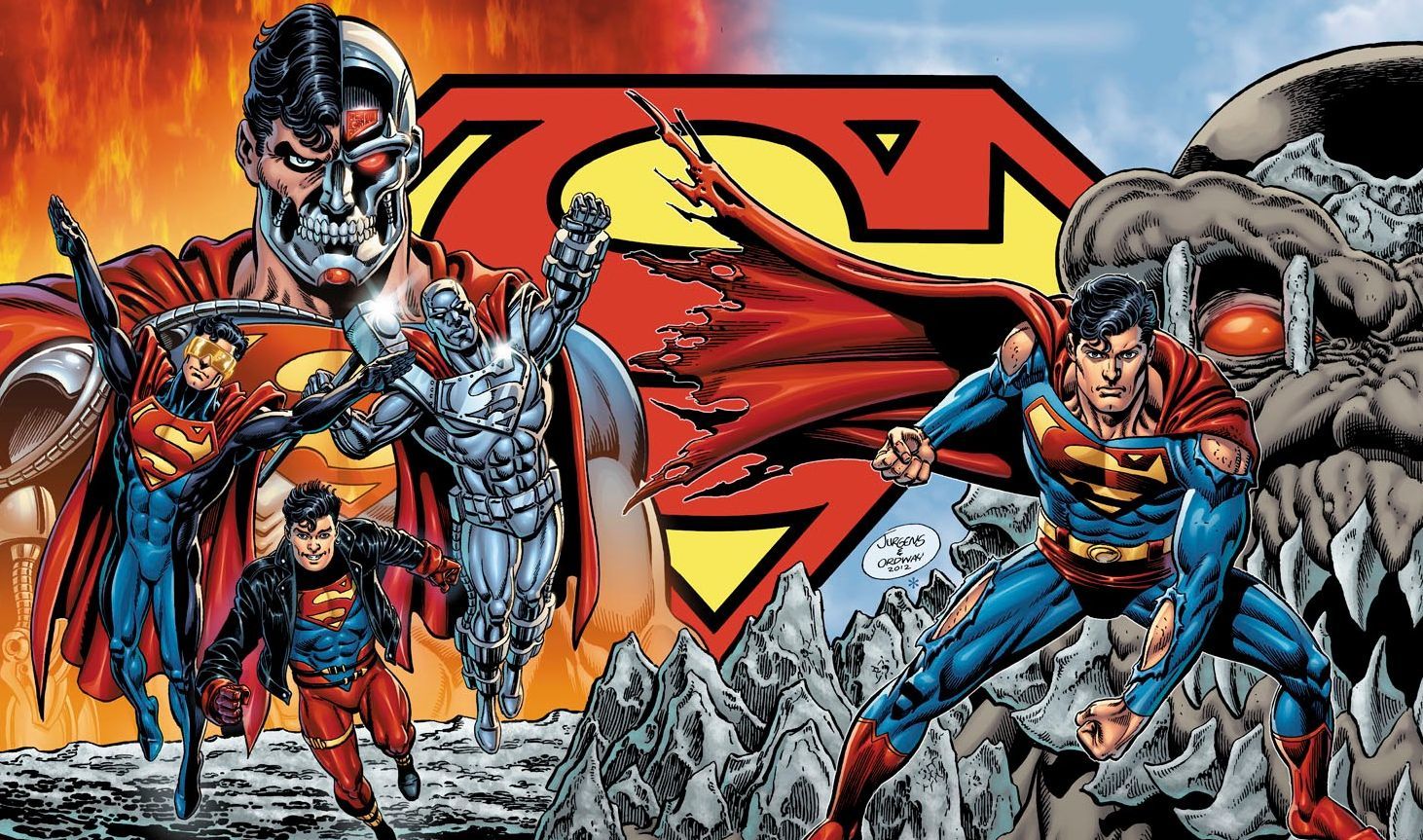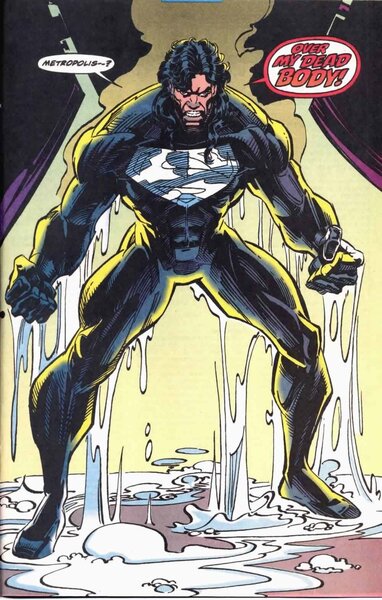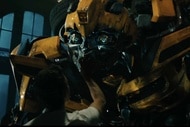Create a free profile to get unlimited access to exclusive videos, sweepstakes, and more!
How DC's Reign of the Supermen brought the beloved character back to life and introduced four new Supermen

In January 1993, the DC Comics team in charge of killing Superman was enjoying Superman #75's unexpected success. How, though, do you follow up a story in which you've killed the most recognizable superhero in the world?
For The Death of Superman's writers — including Dan Jurgens, Louise Simonson, Karl Kesel, and Roger Stern — it was a daunting task. Media, comic book fans, and the industry as a whole had been swept up by the comic book crossover. Many fans, to the delight of DC, believed Superman might stay dead.
Although initial plans called for Superman to return immediately after his death, the editors at DC knew Superman #75's success called for something bigger. In the years leading up to that event, the creative teams behind The Adventures of Superman, Superman: The Man of Steel, and Action Comics had carefully plotted out everything as the books tied together to form an ongoing narrative. Leading up to The Death of Superman, they laid out everything from Doomsday's arrival to Superman's funeral.
Now it was time to bring him back.
Three months later, in the summer of 1993, four mysterious Supermen descended on Metropolis. But who was the real Superman? Was it the super-powered teenage clone? Could Superman have been a cyborg all along? Was the Last Son of Krypton Superman reborn? Could average steelworker John Henry Irons have absorbed the Man of Steel's powers and memories?
Hot on the heels of the Reign of the Supermen animated movie, SYFY WIRE asked comic creators Jurgens and Simonson and longtime Superman writer Jerry Ordway about working on the infamous comic book arc and what it was like creating a team of new Supermen.
In early 1993, an "Emergency Super-Summit" was called. By that time, the bombastic sales numbers for The Death of Superman had come in, and now the pressure was on for the creators to deliver the final act. In a hotel room in Tarrytown, New York, DC editors used big whiteboards to lay out each of the Superman titles in order of publication as writers filled in outline information, including subplots for side characters.
Thanks to a plan by DC Editorial to shelve all Superman titles — a move that would keep secret their plans for the DC hero from the solicitation cycle — the writers were given a bit of breathing room for new stories. Additionally, it helped that fans believed Kal-El might stay dead. With Superman #75 selling millions of copies, DC's initial plans to resurrect him in The Adventures of Superman #500 felt rushed, so they adopted a new Superman.
Ordway had been writing various Superman titles since 1986, and although he read the final arc as a fan, he had a large hand in setting it up, culminating in The Adventures of Superman #500.
"My story involved Pa Kent suffering a heart attack, being in a near-death state while his spirit roams through the limbo between heaven and hell searching for Clark," Ordway says. "As the story discussion took shape, the four teams for the four titles all pitched their ideas for the Superman that would emerge."
Karl Kesel took over writing duties on Adventures of Superman and pitched Superboy. Roger Stern created the Eradicator (Last Son of Krypton), Louise Simonson and Jon Bogdanove came up with Steel, and Dan Jurgens pitched Cyborg Superman. In the end, it was Simonson who suggested the team create all four.
"At an earlier get-together, I made an impassioned speech about how this would be the first time since John Byrne's relaunch that fans would not know what Superman would look like upon his return, and that it was worth using to increase the fans' interest," Ordway says. "The books couldn't be solicited normally, so Mike Carlin agreed that the comics would be solicited with a logo and blacked-out covers, stamped with 'top secret' over them. I loved that! Nowadays, it would be nearly impossible to ensure that level of secrecy."
As Jurgens recalls, Mike Carlin's first words to his team at the Tarrytown Super-Summit were a warning.
"He said, 'We can't screw this up. The whole world is watching, and we have to deliver!" Jurgens says. "Mike was quite right, of course. In all honesty, coming up with the angle of four different characters, each of them claiming to be Superman, really delivered in a major way. We managed to surprise everyone with that approach. But, more importantly, it made for a good, strong story that made the true Superman's return even more special."
"It was great fun, and I'd like to think that making one of them evil really pointed the story in a different, very epic direction," he adds.
THE MAN OF TOMORROW
When Dan Jurgens introduced Hank Henshaw in Superman #42 (and subsequently used him in The Adventures of Superman #466), he was meant to be a one-off character, reminiscent of Reed Richards. In his origin story, Henshaw leads a team of LexCorp space explorers on the shuttle Excalibur. When things go wrong and the crew is hit by cosmic radiation, Henshaw gains superpowers. He is eventually killed by the radiation, his body destroyed, but not before he can upload his consciousness to the ship's computer.
"It was a bit of a take-off on the origin of the Fantastic Four," Jurgens says. "While working on the story, I began to see possibilities for the character and what he might become, so I found a way to bring him back — again, as a type of one-shot story. One of the things I did with that story was to have [him] disappear at the end, leaving Earth so I could pick up on him later."
When it was time to come up with a new Superman, Jurgens went directly to his old creation.
"I wanted to do something different by having mine be a bad guy. And that's when I had the idea of using Hank Henshaw to masquerade as Superman, which resulted in him becoming Cyborg Superman," he says. "I wanted to really pull the rug out from under our readers' feet."
Hank Henshaw soon turned evil, battled the other Supermen, and teamed up with Mongul to destroy Coast City. In the process of destroying Green Lantern's hometown, he also killed most of its 7 million citizens and erected Engine City. Driven mad by Superman, who he blames for his transformation, Cyborg Superman has since been recognized as one of DC's most ambitious and evil villains.
"The moment that we revealed Cyborg Superman as an evil presence was a huge and very fun moment," Jurgens recalls. "Readers never saw that coming — not one of them — and that means we effectively kept that and the entire nature of the four Supermen secret. I don't think there's any way we could do that in today's world."
THE MAN OF STEEL
When Louise Simonson and Jon Bogdanove first started talking about their superhero Steel, they played off the idea of an everyman version of Iron Man. What would Tony Stark do if he weren't rich? What would be his driving motivation for creating a suit made out of steel?
Simonson and Bogdanove were very excited about developing an African-American character during those planning meetings, with the two citing an old folk character named John Henry.
"Steel was created as part of the World without Superman storyline that was the followup to Death. Jon and I are very much in favor of making comics that reflect the world outside our windows in NY--Multiracial, multicultural, multi-religious. We called him John Henry Irons, gave him a hammer and named for the legendary 'Steel-drivin' man,' made to reflect the psyche of Superman," Simonson says.
Simonson said she felt Steel just seemed a natural name for a guy trying to step in for the Man of Steel. Irons was an ironworker and ex-military man who, after being buried alive beneath a building during Superman's fight with Doomsday, builds his own super suit. Wielding a giant iron hammer, Irons assumes Superman's identity but later adopts the name Steel.
"Jon is great at drawing power, action, and emotion, and I loved that in our stories," Simonson says.
Steel was supposed to be an everyman, a hero for the people; from the outset, Simonson wrote Irons as a blue-collar hero, turning down a job from Lex Luthor, saving Lois Lane, and fighting a former partner to get weapons off the street. His working-class background was further revealed as he later confronted the Last Son of Krypton, who he thought was abusing his power.
In an interview with SYFY WIRE last year, Bogdanove said the inspiration for Steel's design stemmed from his love for John Henry as a teen: "When Louise pointed out that he was more than a mere legend, that John Henry was a real historical figure who really did duel a steam-powered drill for the dignity of workers and won at the cost of his life — I knew here was a superhero motif that needed to happen."
DON'T CALL ME SUPERBOY
Known as Connor Kent, or Kon-El, Karl Kesel's version of Superman was created as a brash and reckless clone of both Superman and Lex Luthor. Stepping in to replace Ordway on Adventures of Superman, Kesel and artist Tom Grummett based their version on Superboy and, according to Jurgens, "very wisely pushed the rebel angle a bit."
Although Superboy did not claim to be the recently deceased Superman, he did assume the mantle in Adventures of Superman #501 and vehemently opposed anyone calling him "Superboy," even going so far as to trademark the name Superman.
A major part of Connor Kent's story was that he loved being a hero. Kesel wrote the character exactly as if Superman were a teenager in the 1990s; he wanted the attention, praise, and spoils of saving the world.
After his debut, Superboy became a fan favorite throughout the '90s and starred in his own ongoing series. Most recently, he was resurrected by Brian Michael Bendis in Young Justice #1.
According to a CBR interview with Kesel in 2008, Superboy's design was created long before Kesel had any ideas about the story.
"I had nothing to do with designing Superboy, visually," he said. "Tom Grummett did his usual fantastic job at that — in fact, he drew the initial character sketch during the Superman Summit that came up with the 'Reign of the Supermen' storyline ... well before I wrote one word about the character."
THE LAST SON OF KRYPTON
A Kryptonian alien made of pure power, The Last Son of Krypton served as many people's best guess when they were trying to unravel the mystery of who the real Superman was. Roger Stern began writing Superman comics in 1988 and introduced his version of Superman in Action Comics #687 alongside artists Jackson Guice and Denis Rodier.
The Last Son of Krypton, aka the Eradicator, was seeded in one of Jerry Conway's old stories (Action Comics Annual #2) about ancient Kryptonian technology developed to protect the planet's culture. Stern used the character again in Superman: The Man of Steel #1, in which he was given a humanoid body and ended with the Eradicator being dispersed within the Fortress of Solitude.
Stern told SYFY WIRE last year that during the Super-Summit he thought the Eradicator could serve as a replacement Superman for Action Comics without readers realizing who he was until the ultimate big reveal.
When he appeared again in Action Comics #687, he was depicted as a Superman without Clark Kent, a hero who had little regard for the humans he was set to protect.
In Stern's story, the Last Son of Krypton "saves" Superman by stealing his body and placing it in a regeneration matrix at the Fortress of Solitude. But things begin to go awry as Lois Lane notes his inhuman detachment; reports of the hero's over-the-top methods begin to swirl.
In an interview with the Superman Homepage in 1995, Stern said by the time Action Comics #687 rolled out, he was pretty much finished with the character.
"I really have no feeling for the Eradicator. I wanted him to die at the end of Reign of the Supermen — and, in fact, the original Kryptonian Eradicator did die then — but an 'Eradicator' of some sort had already been promised to the Outsiders office, so I cobbled together the David Connor character. I've been asked to write Eradicator stories ... but I just have no interest in him."
LEGACY OF THE SUPERMEN
Looking back on the death and resurrection of Superman, Ordway says he's gratified to encounter fans who fondly remember the stories and/or cite them as the comics that got them buying Superman.
"That was always the goal for me. I poured our heart into writing and drawing Superman stories, and, while many people loved the work, many more were not interested in even picking up a Superman comic," he says. "DC had a policy that they only spent money to advertise new series, so the only promotion left to us was to try and craft stories that had some epic or buzz-worthy elements."
Jurgens also says he's pleased that fans remember the storyline so well.
"I had a great time doing it and got to work with some fabulous creators who are still friends to this day. It was a very unique time in comics, and seeing that it has endured is quite special," he says. "Every single convention or signing I do has someone — usually more than one, in fact — who approaches me and says, 'I started reading comics because of The Death of Superman.' I have no doubt that we brought a massive number [of] readers to the industry, and a good many are still with us."
For Simonson, the fun was in the experience.
"Oddly, once I understood how it worked, I enjoyed the 'jump rope' nature of working on Man of Steel," she says. "When it's your turn, you jump in with your chapter, then you jump out and the next team jumps in. It was oddly fun, once I got the hang of it. I loved working with Jon Bogdanove, of course. I loved Mike Carlin as editor. Nobody else could had handled it so well. And the rest of the guys who worked on these books."





































